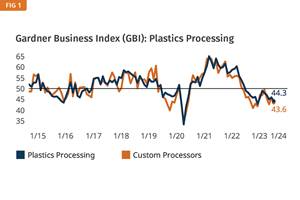If you attended a major international plastics trade show in recent years, you were likely bombarded with messages that the future of plastics processing is “digitalization,” also known as Industry 4.0. That theme will continue in force at October’s K 2019 show, where numerous exhibitors will present their latest features and products for “smart machines, smart processes and smart service.”
But another overarching theme will claim pride of place at this year’s event—“Circular Economy,” which refers to the whole range of strategies for recycling and reuse of plastics waste, as well as design for recyclability. While this will be one of the dominant notes sounded at the show, other elements of sustainability, such as energy savings and lightweighting of plastics parts, will be heard frequently as well.
Recycling via Injection Molding
How does injection molding relate to the idea of the Circular Economy? A number of exhibitors will endeavor to answer that question:
• Because variation in melt viscosity is one of the major challenges to molders of recycled plastics, Engel will show how its iQ weight control software can automatically adjust for such variances “on the fly” to maintain consistent shot weight. “Intelligent assistance opens the door for recycled materials to a far broader range of applications,” says Günther Klammer, the head of Engel’s Plasticizing Systems div. This capability will be demonstrated in molding a ruler from 100% recycled ABS. Molding will switch between two hoppers containing recycled material from two different suppliers, one with 21 MFI and the other 31 MFI.
• A version of this strategy will be demonstrated by Wittmann Battenfeld, using its HiQ-Flow software to compensate for material viscosity variations while molding parts containing reground sprues and parts coming from a new Wittmann G-Max 9 granulator beside the press via vacuum conveying back to the feed hopper.
• KraussMaffei plans to exhibit a complete Circular Economy cycle by molding PP buckets, which will then be shredded and some of the regrind will be reintroduced into molding fresh buckets. Remaining regrind will be compounded with pigments and 20% talc in a KM (formerly Berstorff) ZE 28 twin-screw extruder. Those pellets will be used to back-mold a fabric covering for an automotive A-pillar in a second KM injection machine. KM’s APC Plus control software automatically adjusts for viscosity variations by adjusting the switchover point from injection to holding pressure and the holding pressure level from shot to shot in order to maintain uniform shot weight. A new feature is monitoring the residence time of the melt in the barrel to ensure consistent quality.

Engel’s new skinmelt co-injection sequence: Left—loading the skin material into the barrel with core material. Center—starting injection, with skin material entering the mold first. Right—holding pressure after filling.
• Nissei Plastic Industrial Co. is improving technology for molding biobased, biodegradable and compostable polymers that presumably won’t contribute to the plastics waste problem in oceans and elsewhere. Nissei is focusing on the best known and most widely available biopolymer, polylactic acid (PLA). According to the company, PLA has seen limited use in injection molding because of its poor suitability for deep-draw, thin-wall parts and tendency to short shots in consequence of PLA’s poor flow and mold release.
At K, Nissei will demonstrate practical thin-wall molding technology for 100% PLA, using champagne glasses as an example. To overcome poor flow, Nissei came up with a new method of mixing supercritical carbon dioxide into molten PLA. It reportedly enables thinwall molding at unprecedented levels (0.65 mm) while achieving super-high transparency.
• One way of reusing scrap or recycled plastics is by burying them in the middle layer of a co-injected sandwich structure. Engel is calling its newly enhanced process for this “skinmelt” and claims it can achieve a recycled content over 50%. Engel plans to mold crates with >50% post-consumer PP at its booth during the show. Engel says this is a particular challenge due to the complex geometry of the part. Although sandwich molding is not a new concept, Engel claims to have achieved faster cycles and has developed a new control for the process that allows flexibility to vary the core/skin ratio.
What’s more, unlike “classic” co-injection, the skinmelt process involves accumulating both virgin skin and recycled core melts in one barrel prior to injection. Engel says this avoids the difficulties of controlling and coordinating injection by both barrels simultaneously. Engel uses the main injector for the core material and the second barrel—angled upward over the first—for the skin. The skin material is extruded into the main barrel, in front of the shot of core material, and then a valve closes to shut off the second (skin) barrel from the main (core) barrel. The skin material is the first to enter the mold cavity, pushed forward and against the cavity walls by the core material. Animation of the entire process is displayed on the CC300 control screen.
• In addition, Engel will backmold decorative auto interior components with recycle that is foamed with nitrogen injection. Engel will also be molding post-consumer plastics into miniature waste containers in the outdoor exhibition area between Halls 10 and 16. In another outdoor exhibit nearby will be the recycling pavilion of recycling machinery supplier Erema. There, an Engel machine will mold card boxes from recycled nylon fishnets. These nets have commonly been discarded into the sea, where they are a major hazard to marine life. The reprocessed fishnet material at the K show come from Chile, where three U.S. machine manufacturers have set up collection points for used fishnets. In Chile, the nets are recycled on an Erema system and molded into skateboards and sunglasses on Engel injection presses.
• Arburg will present two examples of Circular Economy as part of its new “arburgGREENworld” program. Around 30% recycled PP (from Erema) will be used to mold eight cups in about 4 sec on a brand-new hybrid Allrounder 1020 H (600 metric tons) in a “Packaging” version (see below). The second example will utilize Arburg’s relatively new Profoam physical foaming process to mold a machine door handle in a two-component press with foamed PCR from household waste and partial overmolding with TPE.
Few details were available on the arburgGREENworld program before the show, but the company says it rests on three pillars named analogously to those in its “arburgXworld” digitalization strategy: Green Machine, Green Production and Green Services. A fourth pillar, Green Environment, includes sustainability in Arburg’s internal production processes.
• Boy Machines will run five different applications of biobased and recycled materials at its booth.
• Wilmington Machinery will discuss a new version (see below) of its MP 800 (800-ton) medium-pressure machine with a 30:1 L/D injection barrel capable of a 50-lb shot. It has a recently developed screw with dual mixing sections, which can perform inline compounding with recycled or virgin materials.
New & Updated Machines
Major hardware developments seem to be less of an emphasis at this show than new control features, services and innovative applications (see next section). But there will be some new introductions, such as these:
• Arburg will introduce an additional size in its new-generation “H” series of hybrid machines. The Allrounder 1020 H has a 600-m.t. clamp, tiebar spacing of 1020 mm, and a new size 7000 injection unit (4.2 kg PS shot capacity), which is also available for the 650-m.t. Allrounder 1120 H, Arburg’s largest machine.
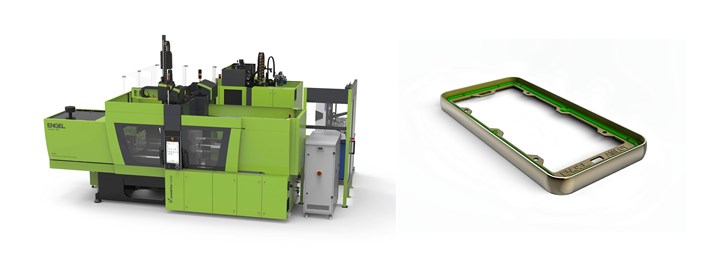
Compact cell pairs Engel's new victory 120 AMM machine for amorphous metal molding with a second, vertical press for overmolding an LSR seal, with robotic transfer between the two.
• Engel will show off a new machine for injection molding liquid amorphous metals (“metallic glasses”). The Heraeus Amloy zirconium-based and copper-based alloys boast a combination of high hardness, strength and elasticity (toughness) not matched by conventional metals and allowing for molding thin-wall parts. Excellent corrosion resistance and surface quality are also claimed. The new victory120 AMM (amorphous metal molding) press is based on a hydraulic victory tiebarless machine with injection speed of 1000 mm/sec standard. It’s said to achieve cycle times up to 70% shorter than previously possible for injection molding amorphous metals. High productivity helps offset the high cost of the amorphous metal, Engel says. Another advantage of Engel’s new alliance with Heraeus is there is no need for a license by molders to practice the technology.
At the show, Engel will present what it says is a first—overmolding amorphous metal with LSR in a fully automated molding cell. After molding the metal substrate, the demo electrical part will be demolded by an Engel viper robot, and then an easix six-axis robot will place the part in a vertical Engel insert molding press with two-station rotary table for overmolding the LSR seal.
• Haitian International (represented here by Absolute Haitian) will present the third generation of three more machine lines, following the introduction of the Jupiter III earlier this year (see April Keeping Up). The upgraded models boast improved efficiency and productivity; optimized drives and an open integration strategy for robotics and automation add flexibility.
One of the new third-generation machines is the all-electric Zhafir Venus III, to be shown in a medical application. It comes with the brand-new, patented Zhafir electric injection unit with significantly increase injection-pressure capability. Said to be attractively priced, it’s available with one, two and four spindles. An optimized toggle design is another feature of the Venus III, which boasts up to 70% energy savings.
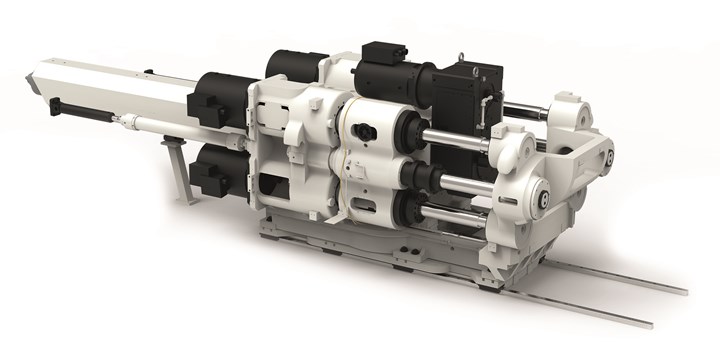
New, patented Haitian Zhafir concept for large electric injection units, with four spindles and four motors.
Third-generation technology will also be shown in the Zhafir Zeres F Series, which adds an integrated hydraulic drive for core pulls and ejectors to the electric Venus design. It will mold packaging with IML at the show.
The new version of “the world’s best-selling injection machine” will be presented as an economical solution for consumer goods in an insert-molding cell with a Hilectro robot from Haitian Drive Systems. The servohydraulic Mars III has a new overall design, new motors, and numerous other improvements analogous to those of the servohydraulic, two-platen Jupiter III Series. A Jupiter III will also run at the show in an automotive application.
• KraussMaffei is launching a larger size in its servohydraulic, two-platen series, the GX 1100 (1100 m.t.). It will mold two PP buckets of 20 L each with IML. Shot weight is about 1.5 kg and cycle time is just 14 sec. The “speed” option for this machine ensures fast injection (up to 700 mm/sec) and clamp movements for molding large packaging with mold-opening distances of more than 350 mm. Dry-cycle time is almost half a second shorter. It also will use an HPS barrier screw for polyolefins (26:1 L/D), said to provide more than 40% higher throughput than standard KM screws.
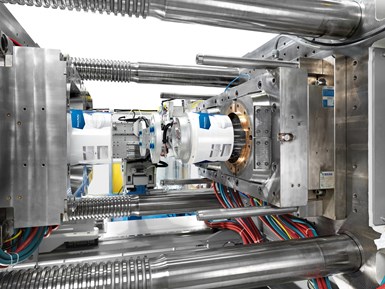
KraussMaffei will debut a larger size in its GX servohydraulic two-platen line. This GX-1100 will mold two 20L PP buckets with IML in just 14 sec. This is also the first KM machine to integrate Netstal’s Smart Operation control option.
In addition, this GX 1100 is the first KM machine equipped with the Smart Operation control option adopted from the Netstal brand, which was recently integrated into KraussMaffei. This option creates separate control environments for setup, which requires maximum flexibility, and production, which requires intuitive and safe machine operation. Guided use of the production screens uses new Smart Buttons and a configurable dashboard. The latter shows machine status, selected process info, and application-specific work instructions, while all other control elements are locked. Smart Buttons actuate automatic startup and shutdown sequences, including automated purge for shutdown. Another button initiates a single-shot cycle at the start of a run. Another button launches continuous cycling. Safety features include, for instance, the need to press start and stop buttons three times in a row, and to hold down a button continuously to move the injection carriage forward.
• Milacron will show off its new “global” Q-Series of servohydraulic toggles, introduced in the U.S. early this year. The new line of55 to 610 tons is based partly on the former Ferromatik F-Series from Germany. Milacron will also show its new Cincinnati line of large servohydraulic two-platen machines, of which a 2250-tonner was shown at NPE2018.

Milacron aims to attract attention with its new Cincinnati large servohydraulic two-platen presses (above) and new Q-Series servohydraulic toggles (below).
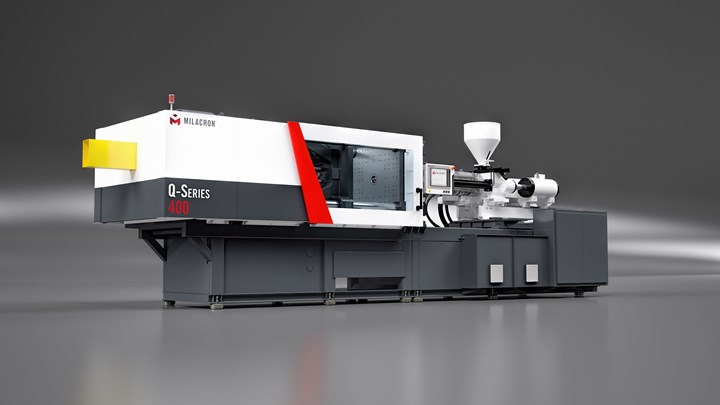
• Negri Bossi will introduced a 600-m.t. size that completes its new Nova sT line of servohydraulic machines from 600 to 1300 m.t. They have a new X-design toggle system that’s said to be so compact as to come close to the footprint of a two-platen clamp. Also shown will be two models of the new Nova eT all-electric range, which appeared at NPE2018.
• Sumitomo (SHI) Demag will display five new entries. Two updated machines in the El-Exis SP high-speed hybrid series for packaging consume up to 20% less energy than their predecessors, thanks to a new control valve that regulates hydraulic pressure during loading of the accumulator. These machines have injection speeds up to 1000 mm/sec. One of the two presses will run a 72-cavity mold to produce 130,000 water-bottle caps per hour.

Sumitomo (SHI) Demag has cut energy consumption of its hybrid El-Exis SP packaging machine by up to 20%, while it can still mold water-bottle caps in 72 cavities at 130,000/hr.
Also new is a larger model in the IntElect all-electric series. The IntElect 500 is a step up from the previous 460-m.t. largest size. It offers larger tiebar spacing, mold height and opening stroke, suiting it to automotive applications that would previously have required a larger tonnage.
The newest size of IntElect S medical machine, 180 m.t., is said to be GMP-compliant and cleanroom-ready, with a mold-area layout that ensures it’s free of contaminants, particles and lubricants. With a dry-cycle time of 1.2 sec, the “S” model outperforms previous generations of IntElect machines. Its extended tiebar spacing and mold height means that multicavity molds can be used with small injection units, said to be especially beneficial to precision medical molders. It’s built for very tight-tolerance applications with cycle times of 3 to 10 sec. It will mold pipette tips in 64 cavities.
And for converting standard machines to multicomponent molding, Sumitomo Demag will unveil its eMultiPlug line of auxiliary injection units, which use the same servo drive as the IntElect machine.
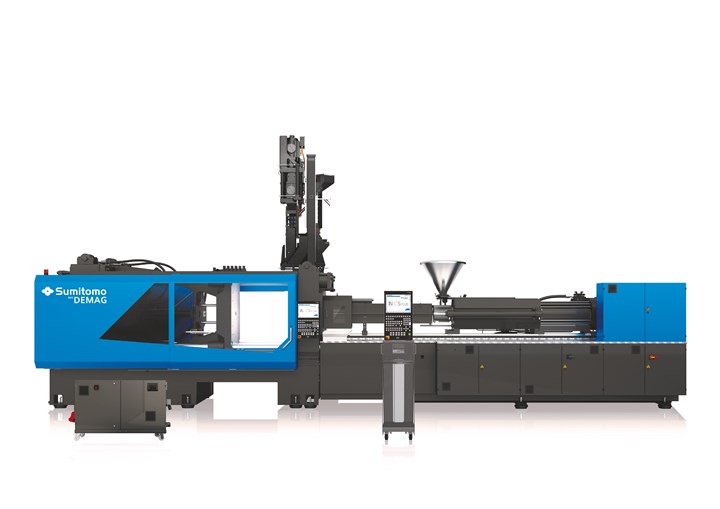
Servo-driven eMultiplug line of auxiliary injection units debuts from Sumitomo Demag.
• Toshiba is displaying a 50-ton model from its new ECSXIII all-electric series, also shown at NPE2018. This is outfitted for LSR, but the integration of cold-runner control with the machine’s enhanced V70 controller reportedly allows easy conversion to thermoplastic hot-runner molding, as well. This machine will be shown with one of Yushin’s latest FRA linear robots, also introduced at NPE.
• Wilmington Machinery has re-engineered its MP800 medium-pressure injection machine since it was presented at NPE2018. This 800-ton, servohydraulic press is aimed at both low-pressure structural foam and standard injection molding at pressures up to 10,000 psi. It has a 50-lb shot capacity and can mold parts measuring up to 72 × 48 in. It was originally designed as a two-stage machine with side-by-side fixed screw and plunger. The new single-stage version has a 130-mm (5.1-in.) diam. reciprocating screw and an inline plunger in front of the screw. Melt passes from the screw through a channel inside the plunger and exits via a ball-check valve at the front of the plunger. Because the plunger has twice the surface area of the screw, this unit can handle a larger shot than usual for a screw of that size. The main reason for the redesign is to provide first-in/first-out melt handling, which avoids exposing some of the melt to excessive residence time and heat history, which can lead to discoloration and degradation of resins and additives. According to Wilmington founder and president Russ La Belle, this inline screw/plunger concept dates back to the 1980s and has also been tested successfully on accumulator-head blow molding machines, which his firm also builds.
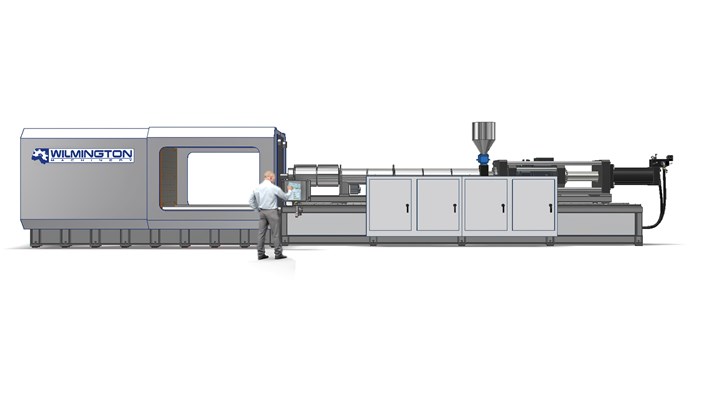
Wilmington Machinery has redesigned its MP800 medium-pressure machine from two-stage injection to single-stage with inline screw and plunger in a single barrel. Resulting FIFO melt handling avoids discoloration and degradation.
The screw of the MP800 injection machine has 30:1 L/D and dual mixing sections, suiting it to compounding with recycled resins and additives or fiber reinforcements.
Wilmington will also be talking about two vertical-clamp structural-foam presses it built recently for a customer looking to save floor space, as well as the advantages of vertical presses in terms of easier mold setup and reduced tool costs. Each of these large servohydraulic presses has 125-lb shot capacity and can accept up to six molds to produce up to 20 parts per cycle. Each mold is filled independently by Wilmington’s proprietary Versafil injection system, which sequences mold filling and provides individual shot control to each mold.
• Wittmann Battenfeld will bring its new 120-m.t. VPower vertical press, shown for the first time in a multicomponent version (see Sept. ’18 Close Up). It will mold an automotive plug of nylon and TPE in a 2+2-cavity mold. The automation system will utilize a SCARA robot and WX142 linear robot to insert the wrap pins, transfer the nylon preforms to the overmold cavities, and remove the finished parts.
Also new from Wittmann will be a high-speed, all-electric EcoPower Xpress 160 in a new medical version. A special screw and drying hopper are provided to mold PET blood tubes in 48 cavities.
New Components, Features, Auxiliaries
A potentially exciting development from Arburg is the addition of mold-filling simulation to a machine controller. Integrating the new “filling assistant” (based on Simcon flow simulation) into the machine control means that the press “knows” the part it will produce. The simulation model created offline and the part geometry are read directly into the control system. Then, in operation, the degree of part filling, relative to the current screw position, is animated in real time as a 3D graphic. The machine operator can compare the results of the simulation created offline with the actual filling performance in the last cycle on the screen monitor. This will aid in optimization of the filling profile.
In recent months, the filling assistant’s capability has been extended to cover a larger spectrum of molds and materials. This feature is available on Arburg’s newest Gestica controller, which will be shown for the first time on an all-electric Allrounder 570 A (200 m.t.). Until now, the Gestica controller has been available only on the new-generation Allrounder H hybrid series of larger presses.
Arburg will also show a new Freeformer model that is capable of 3D printing with fiber reinforcements.
Boy Machines hinted that it will present new plastication technology, called Servo-Plast, as well as a new alternative positioning for its LR 5 linear robot that will save floor space.
Engel will present two new special-purpose screws. The PFS (Physical Foaming Screw) was developed specifically for structural-foam molding with direct gas injection. It reportedly provides better homogenization of the gas-loaded melt and longer life with glass reinforcements. It will be demonstrated with the MuCell microcellular foam process at K.
The second new screw is the LFS (Long Fiber Screw), designed to meet increasing demand for long-glass PP and nylon in automotive applications. It is designed to optimize distribution of the fiber bundles while minimizing fiber breakage and screw wear. Engel’s previous solution was a screw with a bolt-on mixing head for the long glass. The LFS is a one-piece design with a refined geometry.
Engel is also introducing three automation products. One is viper linear servo robots with longer takeoff strokes but the same payload capacities as before. For example, the viper 20 has its “X” stroke enlarged from 900 mm to 1100 mm, enabling it to fully reach Euro pallets—a task previously requiring a viper 40. The X-stroke extension will be an option for viper models 12 to 60.
Engel says this enhancement was made possible by two “smart” inject 4.0 functions: iQ vibration control, which actively damps vibrations, and the new “multidynamic” function, which adjusts speeds of the robot’s motions according to the payload. In other words, the robot automatically moves faster with lighter loads, slower with heavier ones. Both software features are now standard on viper robots.
Also new is a pneumatic sprue picker, Engel pic A, said to be both the longest-lasting and the most compact sprue picker on the market. Instead of the usual rigid X axis, the pic A has a swivel arm that moves within a very tight area. The takeoff stroke is continuously variable up to 400 mm. Also new is ability to adjust the Y axis in just a few steps; and the A axis rotation angle automatically adjusts between 0° and 90°. Ease of operation is said to be a particular benefit: When fully swiveled in, the pic A leaves the entire mold area free, facilitating mold changes. “The time-consuming process of swiveling out the sprue picker and setting the XY adjustment unit is history,” Engel states.
Engel is also showing for the first time its “compact safety cell,” described as a cost-effective, standardized solution for minimizing footprint and ensuring safe interaction between cell components. A medical cell will demonstrate this concept with parts handling and box changing—all significantly slimmer than standard safety guarding. When the cell is opened up, the box changer moves automatically to the side, giving open access to the mold. The standardized design can accommodate additional components, such as a multi-tiered conveyor belt or tray server, and enables fast changeovers, even in cleanroom environments.
Milacron will show off its pioneering position as the first machine builder to integrate the novel iMFLUX low-pressure injection process into its Mosaic machine controls, first introduced at last October’s Fakuma 2018 show in Germany. This process is claimed to speed cycles while molding at lower pressures and providing more stress-free parts. (See feature article in this issue for more on iMFLUX.)
Trexel will show off two of its newest equipment developments for MuCell microcellular foaming: the P-Series gas-metering unit, its first suitable for fast-cycling packaging applications (also shown at NPE2018); and the brand-new Tip Dosing Module (TDM), which eliminates the need for the previous special screw and barrel, is retrofittable on standard screws, is gentler to fiber reinforcements, and boosts output (see June Keeping Up).
In robots, Sepro is highlighting its newest model, the S5-25 Speed Cartesian model that’s 50% faster than the standard S5-25. It reportedly can get in and out of the mold space in under 1 sec. Also on display are cobots from Universal Robots, which SeprSepro America, LLCo is now offering with its Visual controls.
Wittmann Battenfeld will operate several of its new X-series linear robots with advanced R9 controls (shown at NPE), as well as a new high-speed model.
The ‘Wow’ Factor
As always, the main attraction of K will be live molding demonstrations with an undeniable “Wow” factor that can inspire attendees to challenge the limits of today’s technology.
Engel, for example, is pulling out the stops in several exhibits aimed at automotive, electrical and medical markets. For automotive lightweight structural composites, Engel is upping the ante in process complexity and design flexibility. To illustrate current auto-industry R&D into molding parts with targeted load distribution, Engel will operate a cell that preheats, preforms and overmolds three differently shaped organosheets in a fully automated process that involves two integrated infrared ovens and three six-axis robots.
The heart of the cell is a duo 800-m.t. two-platen press with a CC300 controller (and C10 handheld tablet pendant) that coordinates all of the cell’s components (including collision checking) and stores all their operating programs. That involves 18 robot axes and 20 IR heat zones, and integrated sheet-stacking magazines and conveyors, with just a single Start button and a Stop button that sends all components to their home positions. 3D simulation was used to program this complex cell.
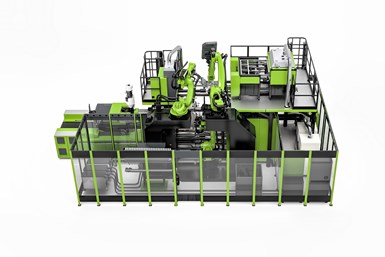
Engel’s unusually complex cell for lightweight structural automotive composites utilizes three PP/glass organosheets of different thicknesses, which are preheated, preformed and overmolded in a cell integrating two IR ovens and three six-axis robots.
The material for the organosheets is woven continuous glass and PP. Two IR ovens—designed and built by Engel—are mounted atop the machine, one vertically, one horizontally. The vertical oven is positioned directly above the clamp so that the thinnest sheet (0.6 mm) reaches the mold immediately, with little heat loss. A standard horizontal IR oven on a pedestal above the moving platen preheats the two thicker sheets (1 mm and 2.5 mm). This arrangement shortens the distance between oven and mold and saves space, since the oven occupies no floor space.
All organosheets are preheated simultaneously. The sheets are preformed in the mold and overmolded with glass-filled PP in a cycle of about 70 sec. One easix robot handles the thinnest sheet, holding it in front of the oven, and another handles the two thicker sheets. The second robot places the thicker sheets in the horizontal oven and then in the mold (with some overlap). The thickest sheet requires an extra preforming cycle in a separate cavity while the part is being molded. The third robot (floor-mounted, while the others are on top of the machine) moves the thickest sheet from the preforming cavity to the molding cavity and demolds the finished part. Engel notes that this process achieves an “outstanding grained leather look, which was previously considered impossible when it came to organic sheets.” This demonstration is said to “lay the foundation for producing large structural thermoplastic door structures using the organomelt process.”
Engel will also demonstrate decorative processes for interior and exterior auto parts. In cooperation with Leonhard Kurz, Engel will operate a roll-to-roll in-mold foil decoration process that vacuum forms, backmolds and diecuts foils in a one-step process. The process is suited to multilayer foils with paint-film surfaces, as well as structured, backlightable and functionalized foils with capacitive electronics. Kurz’s new IMD Varioform foils are said to overcome previous limitations on backmolding compex 3D shapes. At K, Engel will backmold the foil with shredded plant scrap (parts with foil covering) that is foamed with Trexel’s MuCell process. Though this application was shown at Fakuma 2018, Engel has further refined the process to trim the product completely in the mold, eliminating a post-mold laser-cutting step.
A second IMD application will use an Engel system at Kurz’s booth to overmold thermoplastic front panels with a clear, two-component liquid PUR topcoat for gloss and scratch resistance. The result is said to meet requirements for exterior safety sensors.
Because LED lighting is popular as a styling element in cars, Engel developed a new plasticating process specifically for acrylic (PMMA) to achieve high luminous efficiency and minimize transmission losses. High-quality melt is also needed to fill out fine optical structures around 1 mm wide × 1.2 mm high.
Wittmann Battenfeld will also use Kurz’s IMD Varioform foils to mold an auto headliner with a functional surface. It has a partially translucent decorative sheet on the outside and a functional sheet with a printed touch-sensor structure on the inside of the part. A linear robot with a servo C axis has an IR heater on the Y-axis to preheat the continuous sheet. After the functional sheet is inserted in the mold, the decorative sheet is pulled from a roll, heated and vacuum formed. Then both sheets are overmolded.
In a separate demonstration, Wittmann will use its Cellmould microcellular foam process to mold a seat-bench support for a German sports car from a Borealis PP compound containing 25% PCR and 25% talc. The cell will utilize Wittmann’s new Sede gas unit, which extracts nitrogen from the air and pressurizes it up to 330 bar (~4800 psi).
For medical and electronics parts, Engel plans two multicomponent molding exhibits. One is the two-machine cell mentioned above that molds an electronic part in amorphous metal and then overmolds it with an LSR seal in the second press. The other demonstration is molding a thick -walled medical housing of clear and colored PP. Using a technique previously applied to thick optical lenses, molding a part 25 mm thick in two layers drastically reduces the cycle time, which would be as long as 20 min if molded in one shot, Engel reports.
The process uses an eight-cavity Vario Spinstack mold from Hack Formenbau in Germany. It is equipped with a vertical indexing shaft with four positions: 1) injecting the clear PP body; 2) cooling; 3) overmolding with colored PP; 4) demolding with a robot. A clear sight glass can be inserted during molding. Stack rotation and operation of eight core pulls are all driven by electric servomotors using new software developed by Engel. Servo control of mold actions is integrated into the press controller.
Among the eight molding exhibits at Arburg’s booth will be a functional IMD demonstration of Injection Molded Structured Electronics (IMSE), in which films with integrated electronic functions are overmolded to produce a night light.
Another Arburg exhibit will be LSR micromolding, using an 8-mm screw, eight-cavity mold, and LSR material cartridge to mold microswitches weighing 0.009 g in around 20 sec.
Wittmann Battenfeld will mold LSR medical valves in a 16-cavity mold from Nexus Elastomer Systems of Austria. The system uses the new Nexus Servomix metering system with OPC-UA integration for Industry 4.0 networking. This servo-driven system is said to guarantee elimination of air bubbles, offer easy change of drums, and to leave <0.4% material in empty drums. In addition, Nexus’ Timeshot cold-runner system offers independent needle shutoff control of up to 128 cavities and overall control by injection time.
A Wittmann Battenfeld machine will mold a particularly challenging LSR part at the booth of Sigma Engineering, whose simulation software helped make it possible. A potholder weighing 83 g has a 1-mm wall thickness over 135 mm flow length (see Dec. ’18 Starting Up).
Negri Bossi will show a new, patented method for converting a horizontal injection machine into an injection-blow molder for small roll-on deodorant bottles, using a mold from Molmasa of Spain. Another machine at the NB booth will produce a broom brush from foamed WPC (wood-plastic compound) using the company’s FMC (Foam Microcellular Molding) process. Available for both thermoplastics and LSR, this technique injects nitrogen gas into a channel in the center of the screw through a port behind the feed section. Gas enters the melt through a series of “needles” in the metering section during plastication.

Cosmetic jars and lids based 100% on natural materials will be made by Wittmann Battenfeld in a cell that screws the two parts together after molding.
Wittmann Battenfeld will mold cosmetic jars with lids from a material based 100% on natural ingredients, which reportedly can be recycled without any loss of properties. A two-component press with 4+4-cavity mold will mold the jars with IML using the main injector and the lids with the secondary unit in an “L” configuration. Two linear robots are used—one for label placement and demolding of the jars and one to demold the lids. Both parts are placed in a secondary station to be screwed together.
More Tech for ‘Smart Factories’
Although perhaps not the star of the show this year, the theme of “digitalization” or Industry 4.0 will certainly have a strong presence. Machine suppliers are building out their platforms of “smart machines, smart processes, and smart service”:
• Arburg is making its machines smarter with filling simulation integrated into the controls (see above), and a new “Plasticising Assistant” whose functions include predictive maintenance of screw wear. Smarter production takes advantage of the new Arburg Turnkey Control Module (ACTM), a SCADA (supervisory control and data acquisition) system for complex turnkey cells. It visualizes the complete process, captures all relevant data, and transmits job-specific data sets to an evaluation system for archiving or analysis.
And in the category of “smart service,” the “arburgXworld” customer portal, which has been available in Germany since March, will be available internationally as of K 2019. In addition to free functions such as the main Machine Center, Service Center, Shop and Calendar apps, there will be additional fee-based functions introduced at the fair. These include the “Self Service” dashboard for machine status, the control system simulator, collection of process data, and details of the machine design.
• Boy will produce a hard/soft overmolded drinking cup with individualized production for show visitors. Production data and individual key data for each cup molded are stored and retrievable from a server.
• Engel is emphasizing two new “smart” control functions. One is iQ melt control, an “intelligent assistant” for optimizing the process. It automatically adjusts plasticating time to minimize screw and barrel wear without extending the cycle, and it suggests optimal settings for barrel-temperature profile and backpressure, based on the material and screw design. The assistant also verifies that the particular screw, barrel and check valve are suitable for the current application.
Another new intelligent assistant is iQ process observer, described as the company’s first feature fully embracing artificial intelligence. Whereas previous iQ modules are designed to optimize individual elements of the molding process, such as injection and cooling, this new software provides an overview of the entire process for the whole job. It analyzes several hundred process parameters across all four phases of the process—plasticating, injection, cooling and demolding—to make it easy to spot any changes at an early stage. The software splits the analysis results into the four phases of the process and presents them in an easy-to-understand overview on both the injection machine’s CC300 controller and the Engel e-connect customer portal for remote, anytime viewing.
Designed for the process engineer, iQ process observer facilitates quicker troubleshooting with early detection of drifts, and suggests ways to optimize the process. Based on Engel’s accumulated processing know-how, it’s described as “the first proactive process monitor.”
Engel promises that there will be more introductions at K, including more condition monitoring features and the commercial launch of an “edge device” that can collect and visualize data from auxiliary equipment and even multiple injection machines. It will enable users to see process settings and operating state of a wide range of equipment and send the data to an MES/MRP computer like Engel’s TIG and others.
• Wittmann Battenfeld will be demonstrating its HiQ intelligent software packages, including the newest, HiQ-Metering, which ensures positive closing of the check valve prior to injection. Another new element of the Wittmann 4.0 program is the electronic mold data sheet, which stores settings for both the injection machine and Wittmann auxiliaries to permit setup of an entire cell with a single keystroke. The company will also show off its condition monitoring system for predictive maintenance, as well as a product of its new stake in Italian MES software supplier Ice-Flex: TEMI+ is described as a simple, entry-level data-collection system that’s integrated with the injection machine’s Unilog B8 controls.
• News in this area from KraussMaffei includes a new retrofit program to equip all KM machines of any generation with web-enabled networking and data-exchange capabilities for Industry 4.0. This offering comes from KM’s new Digital & Service Solutions (DSS) business unit. Among its new offerings will be condition monitoring for predictive maintenance and “data analysis as a service” under the slogan, “We help to unlock the value of your data.” The latter will be a function of KM’s new Social Production app, which the company says, “uses the advantages of social media for a completely new type of production monitoring.” This patent-pending function identifies process disturbances autonomously, based on underlying data, without any user configuration, and provides tips on possible solutions. Like Engel’s iQ process observer mentioned above, Social Production reportedly makes it possible to detect and prevent or solve problems at an early stage. What’s more, KM says the system is compatible with all brands of injection machines. Its industrial messenger function is intended to replace messaging programs such as WhatsApp or WeChat as a means to simplify and accelerate communication and collaboration in manufacturing.
KM will also debut a new enhancement of its DataXplorer software, which provides a detailed view of the process in depth by collecting up to 500 signals from the machine, mold or elsewhere every 5 millisec and graphs the results. New at the show will be a central data-collection point for all elements of a production cell, including auxiliaries and automation. Data can be exported to MES or MRP systems. The system can be implemented in a modular structure.
• Milacron will highlight its M-Powered web portal and suite of data analytics with capabilities such as “MES-like functionality,” OEE (overall equipment efficiency) monitoring, intuitive dashboards, and predictive maintenance.

Industry 4.0 advances: Engel’s new iQ process observer (left); Milacron’s M-Powered (center); KraussMaffei’s DataXplorer.
• Negri Bossi will show off a new feature of its Amico 4.0 system for collecting data from a variety of machines with different standards and protocols and sending that data to the customer’s ERP system and/or to the cloud. This is accomplished via an interface from Open Plast of Italy, a company dedicated to implementing Industry 4.0 in plastics processing.
• Sumitomo (SHI) Demag will present a connected cell featuring its latest offerings in remote diagnostics, online support, document tracking and spare-parts ordering via its myConnect customer portal.
• While the most active discussion of Industry 4.0 has up to now come from European and American suppliers, Nissei will present its efforts to accelerate development of an Industry 4.0-enabled controller, “Nissei 40.” Its new TACT5 controller is equipped as standard with both the OPC UA communication protocol and the Euromap 77 (basic) MES communication protocol. The goal is for the machine controller to be the core of a network of auxiliary cell equipment such as robot, material feeder, etc. with the aid of the still-developing Euromap 82 protocols and EtherCAT. Nissei envisions setting up all the cell auxiliaries from the press controller. Wireless networks will minimize wires and cables and will permit remote maintenance. Nissei is also developing its “N-Constellation” concept for an IoT-based automatic quality inspection system.
Related Content
Plastics Processing Business Index Contracts Further
All components dip as index hits low point of 2023.
Read MorePlastics Index Shows Supply Chain Improvement Despite Production Slowdown
Future expectations reach 2024 high on the heels of the recent election.
Read MoreProcessing Megatrends Drive New Product Developments at NPE2024
It’s all about sustainability and the circular economy, and it will be on display in Orlando across all the major processes. But there will be plenty to see in automation, AI and machine learning as well.
Read MorePlastics Processing Activity Contraction Continues in August
Four months of consecutive contraction overall.
Read MoreRead Next
Lead the Conversation, Change the Conversation
Coverage of single-use plastics can be both misleading and demoralizing. Here are 10 tips for changing the perception of the plastics industry at your company and in your community.
Read MoreMaking the Circular Economy a Reality
Driven by brand owner demands and new worldwide legislation, the entire supply chain is working toward the shift to circularity, with some evidence the circular economy has already begun.
Read MoreFor PLASTICS' CEO Seaholm, NPE to Shine Light on Sustainability Successes
With advocacy, communication and sustainability as three main pillars, Seaholm leads a trade association to NPE that ‘is more active today than we have ever been.’
Read More
















